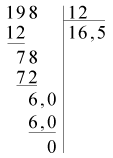MathML 3 elementary math examples
Elementary math elements
MathML 3 adds several elements to handle elementary math problems. The elementary math elements below should be inside of either an mstack or an mlongdiv element. Both mstack and mlongdiv make the digits of numbers contained in them be in their own columns and their children appear in their own row; mlongdiv's first three children are the divisor, dividend, and result and are treated specially.
msgroupgroups rows with similar alignment; options control the position and shifting of children (see multiplication and division examples below)msrowgroups digits and operators into a row; options control the position of the childrenmslinedraws lines between rows of the stack; options control the position, length, thickness, and overhang of the linemscarriesannotates the following row with optional borrows/carries and/or crossouts; options control the default location, style, and size of the borrows, carries, and crossoutsmscarrya borrow/carry and/or crossout for a single digit; options control the location, style, and size of the borrow, carry, and/or crossout
If a blank entry in a column is needed, the element none can be used. This is shown in some of the examples below.
Addition, subtraction, and multiplication problems
Here's a simple addition problem that spaces the "+" away from the operand by using the element none:
| |
Here's a more complicated subtraction problem that shows carries and borrows and crossouts:
| |
Notice that the carry/borrow default of "n" (north/above) is changed to the "nw" (northwest) position by mscarries, but that is overridden for the borrow and changed back to "n". The carry/borrow can be in any compass position. Several different styles for crossouts are possible.
Here's a multiplication problem that shows multiple rows of carries:
| |
There are a few things to note about this example:
We specified loose spacing between the characters on the
mstacktag; absolute values such as "10px" can also be given.The carries are shifted over; we could also have used an
msrowandnone, but specifying a position is simpler.The '874' uses
msrowto shift the number over one column, but a "0" could have been added and this would not have been needed; alternatively, msgroup with shift="1" could have been used, similar to what is done in the long division problem in our next example.
Long division
There are many different styles of long division used around the world. MathML has ten named styles, but the list is open-ended. All styles share how the intermediate steps are displayed, but differ in the placement of the divisor, result, and where lines are drawn. The default style is the style used in the U.S., Great Britain, and elsewhere.
Below are two examples that differ only in the style and what character is used for the decimal separator. Because the separator is typically set on the math element, it is included in these examples.
| |
| |
Repeating decimal
There are two common styles for indicating a repeating decimal in a decimal expansion of fractions like ⅓. The most common style puts a line above the part that repeats and the other style puts dots on the first and last digits of the part that repeats. Both are easy to write as shown below:
| |
| |
MathML makes elementary math accessible
The video below shows a prototype of MathPlayer speaking and highlighting the speech for two elementary math examples:
 |






